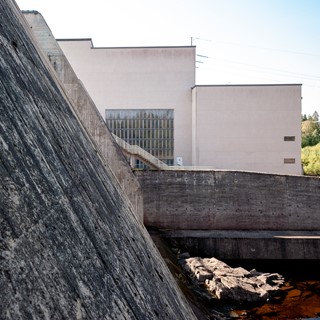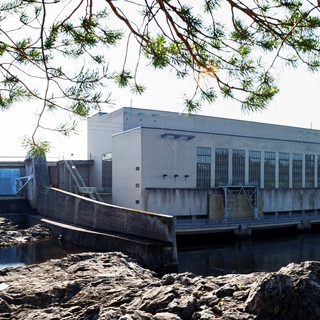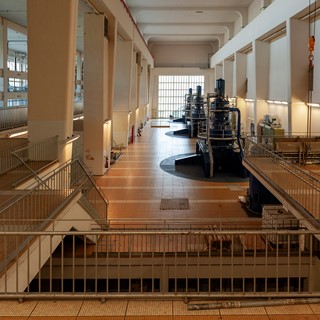Jylhämä
Jylhämä was an important power plant in terms of the whole venture, of harnessing the hydroelectric power of the River Oulujoki. It is the first power plant on the River Oulujoki that flows from Lake Oulujärvi to the Baltic Sea. It also functions as a regulating dam for Lake. Large earthmoving works and long embankments molded the landscape in Jylhämä. The power plant was finished in 1951 and it has a maximum capacity of 55 megawatts.
History
In 1946, only two power plants on the river Oulujoki were under construction. Finland was suffering from an electricity shortage following the war, so it was urgent to get new hydroelectric projects started. Niskakoski falls, in the municipality of Vaala, was going to be divided between two power plants. Jylhämä was going to be built upstream and Nuojua to the lower part of the rapids.[1]
Jylhämä was also going to function as a regulating dam for Lake Oulujärvi. So, the water level for the reservoir would be the same as the water level of the lake. The regulation level for Lake Oulujärvi was set to 123.2 meters above sea level.[2]
The construction started during the summer of 1946. Jylhämä was going to be built in the middle of wilderness and the area did not have proper roads or housing. So, the first 1.5 years was spent setting up a modern builder community. To make sure the builders would have enough timber, Oulujoki Power Company had bought the Vaala Sawmill that was located nearby.[3]
The biggest obstacles in building Jylhämä had to do with earthmoving and excavating. Machines were not available because of the shortages following the war, so most of the work had to be carried out manually. The situation got better in 1948 and after this, most of the work could be done with machines.[4]
A total of 1.5 million cubic meters of earth had to be removed, when building the earth fill dams and digging the canals. This meant that Jylhämä was, at the time, the second largest earth moving job in Finnish history. When at its busiest, over 2,000 men and dozens of machines worked at the construction site. Construction was finished in a total of three years.[5]
At the same time, the power house and the concrete dam were under construction. A concrete mixing plant had also been built on the south shore. The power house was built with an in-situ concrete frame, plastered facades and horizontal windows. Turbines had been ordered from Tampella and the generator from a Swiss company, Oerlikon. The first set of machinery was connected to the power grid on 19 June 1950, the second one on 3 December 1950 and the third on 30 December 1951. [6]
[1] Mauri Kuuskoski, Pekka Salminen, Jouko Vahtola, Paavo Vasala. Vesivoimaa Oulujoesta 50 vuotta: sähkölla eteenpäin. Oulu: Oulujoki Oy, 1991, 27
[2] Matti Enbuske. Pohjois-Pohjanmaan ympäristöhistoria. Oulu: Pohjois-Pohjanmaan ELY-keskus ympäristö ja luonnonvarat -vastuualue, 2010, 315
[3] Mauri Kuuskoski, Pekka Salminen, Jouko Vahtola, Paavo Vasala. Vesivoimaa Oulujoesta 50 vuotta: sähkölla eteenpäin. Oulu: Oulujoki Oy, 1991, 28
[4] Matti Enbuske. Pohjois-Pohjanmaan ympäristöhistoria. Oulu: Pohjois-Pohjanmaan ELY-keskus ympäristö ja luonnonvarat -vastuualue, 2010, 316
[5] Mauri Kuuskoski, Pekka Salminen, Jouko Vahtola, Paavo Vasala. Vesivoimaa Oulujoesta 50 vuotta: sähkölla eteenpäin. Oulu: Oulujoki Oy, 1991, 35
[6] Ibid, 36
Technical information
Owner: Fortum Power and Heat
Built: 1946-1951
Designer: Aarne Ervi, architect
Capacity: 55 MW, head 11-14 m
Power house: In-situ concrete frame, plastered facades, horizontal windows
Specialities: Jylhämä outdoor museum, Uutela farm
Protection status: Classified as RKY (Nationally significant built cultural environment – RKY 2009: Hydropower plants on the River Oulujoki and Sotkamo Route), district plan, Docomomo site[7]
[7] Veli-Pekka Huhmo. Oulujoen vesistön voimalaitosarkkitehtuuria. Oulu: Humanpolis Oy, 2017, 78
Residential area
Jylhämä has a large residential area with houses built between 1940s and 1970s.

Images
All pictures below are part of the power plant's history. All images are copyrighted. You may use the images for personal use but the images may not be used in commercial contexts or printed matter without our permission. Click on the pictures to enlarge them.
Stories
Here you can read other people's stories about the power plant. And if you have your own story, please share it. Whether you want it to be published on the site or not, we are interested in all stories.
Do you have a story about the powerplant or life around the river?
Send us your story
Visitor information
Below you can read about everything you need to know before a possible visit to the power plant. When it is best to visit the power plant, how to find here and about the rules that apply in the area.



